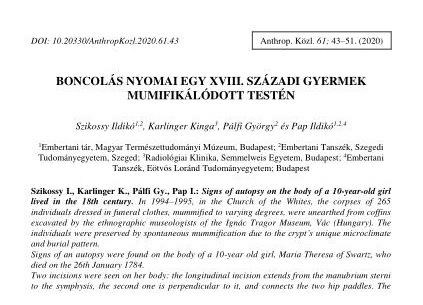Boncolás nyomai egy XVIII. századi gyermek mumifikálódott testén
Absztrakt
In 1994–1995, in the Church of the Whites, the corpses of 265 individuals dressed in funeral clothes, mummified to varying degrees, were unearthed from coffins excavated by the ethnographic museologists of the Ignác Tragor Museum, Vác (Hungary). The individuals were preserved by spontaneous mummification due to the crypt’s unique microclimate and burial pattern.
Signs of an autopsy were found on the body of a 10-year old girl, Maria Theresa of Swartz, who died on the 26th January 1784.
Two incisions were seen on her body: the longitudinal incision extends from the manubrium sterni to the symphysis, the second one is perpendicular to it, and connects the two hip paddles. The wound edges were later sutured, and the suture was partially retained. Since there was no sign of any other opening in the body, the autopsy was apparently aimed at finding out the cause of death and was limited to the area of the suspected disease. Rapid miliary tuberculosis and extrapulmonary bone tuberculosis must have contributed to the child's death; this was demonstrated by radiological examinations and confirmed by paleomicrobiological examination (residues of Mycobacterium tuberculosis detected in pulmonary and extrapulmonary samples as well). Another hypothesis is that appendicitis might have caused the death of a child with advanced tuberculosis. In the case of appendicitis, the intestinal function may stop. Suspected abdominal complaints may also have been caused by extrapulmonary gastrointestinal tuberculosis.
Hivatkozások
Donoghue, H.D., Pap, I., Szikossy, I., Spigelman, M. (2011): Detection and characterization of Mycobacterium tuberculosis DNA in 18th century Hungarians with pulmonary and extrapulmonary tuberculosis. Yearbook of Mummy Studies, 1: 51–56.
Donoghue, H.D., Spigelman, M., Szikossy, I., Pap, I. (2020): Publikálatlan egyéni adatok. Kézirat.
Fletcher, H.A., Donoghue, H.D., Holton, J., Pap, I., Spigelman, M. (2003): Widespread occurrence of Mycobacterium tuberculosis DNA from 18th–19th century Hungarians. American Journal of Physical Anthropology, 120: 144–152. DOI: 10.1002/ajpa.10114
Pap, I., Susa, É., Józsa, L. (1997): Mummies from the 18th–19th century Dominican Church of Vác, Hungary. Acta Biologica Szegediensis, 42: 107–112.
Pap, I., Józsa, L., Repa, I., Bajzik, G., Lakhani, S.R., Donoghue, H.D., Spigelman, M. (1999): 18–19th century tuberculosis in naturally mummified individuals (Vác, Hungary). In: Pálfi, Gy., Dutour, O., Deák, J., Hutás, I. (Eds) Tuberculosis: Past and Present. Budapest – Szeged. pp. 419–428.
Pap, I., Pálfi, Gy., Molnár, E., Karlinger, K., K. Kovács, B., Korom, Cs., Schultz, M., Schmidt-Schultz, T.H., Spigelman, M., Donoghue, H.D., Kustár, Á., Szikossy, I. (2017): A tuberkulózis előfordulása egy XVIII. századi váci családban. Anthropologiai Közlemények, 58: 37–47. DOI: 10.20330/AnthropKozl.2017.58.37
Susa, É. (1995): Előzetes jelentés a váci Fehérek temploma kriptafeltárásáról. Anthropologiai Közlemények, 37: 1 92–193.
Susa, É., Józsa, L. (1995): A múmiakészítés technikája és eredményei az ókortól napjainkig. Anthropologiai Közlemények, 37: 100–118.
Szikossy, I., Bernert, Zs., Pap, I. (1997): Anthropological investigation of the 18th–19th century ossuary of the Dominican Church, Vác, Hungary. Acta Biologica Szegediensis, 42: 145–150.
Tragor Ignác Múzeum (1995): A váci Fehérek temploma feltárási dokumentációja. ND 95.3.2.1–262.
Zomborka, M. (1996): Vác „Fehérek temploma” kriptafeltárás. 1994–95. Magyar Múzeumok, 2(1): 3–7.




